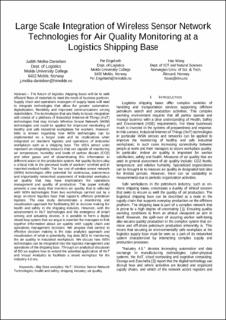| dc.description.abstract | The future of logistics shipping bases will be to seek efficient flows of materials to meet the needs of business partners. Supply chain and operations managers of supply bases will need to integrate technologies that allow for greater automation, digitalization, flexibility and improved communications among stakeholders. The tech- nologies that are likely to boost integration will consist of a plethora of Industrial Internet-of-Things (IIoT) technologies that may include Wireless Sensor Network (WSN) technologies and could be applied for improved monitoring of healthy and safe industrial workplaces for workers. However, little is known regarding how WSN technologies can be implemented on a larger scale and its implications when integrated on standard logistics and operations of industrial workplaces such as a shipping base. The WSN sensor units represent an integrating resource that are capable of monitoring air temperature, humidity and levels of carbon dioxide (CO2) and other gasses and of disseminating this information to different actors in the production system. Air quality factors play a critical role in the perceived levels of workers' comfort and in reported medical health. The low cost of wireless sensor network (WSN) technologies offer potential for continuous, autonomous and importantly networked assessment of industrial workplace air quality that may have implications for operations management and quality of production. This paper initially presents a case study that monitors air quality that is collected with WSN technologies from two workshops carried out by a large on-shore logistics base that supports offshore petroleum logistics. The case study demonstrates a monitoring and visualization approach for facilitating BD in decision making for health and safety in the shipping industry. However, with the advancement in IIoT tech- nologies and the emergence of smart sensing and actuating devices, it is possible to form a digital closed-loop system that we argue is essential for managers to link together information about air quality with supply chain and operations management decisions. We propose that central to effective decision making is the data analytics approach and visualization of what is potentially, big data (BD) in monitoring the air quality in industrial workplaces. We discuss how WSN technologies can be integrated into the logistics management and operations of the shipping base. Through an analytical discussion of BD we explore how to extend the potential application of IIoT and Visual Analytics to facilitate a smart workplace for the Industry 4.0 era. Keywords: Big Data analytics, IIoT, Wireless Sensor Network Technologies, health and safety, shipping industry, air qualit | en_US |
